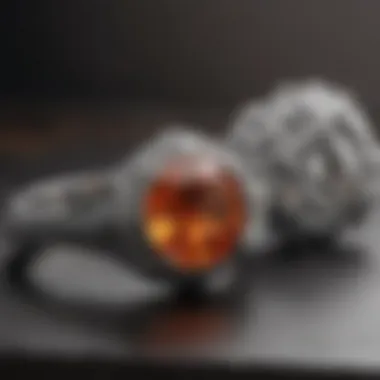Exploring the Bridge Setting for Engagement Rings


Intro
The allure of engagement rings often resides in their ability to tell a unique story, both through the choice of metal and the design that surrounds it. One such captivating style is the bridge setting, which seamlessly combines beauty and functionality. As we dive into the nuances of this setting, it’s essential to appreciate its defining characteristics and the role it plays in enhancing both the durability and aesthetic appeal of the ring.
A bridge setting not only highlights the central gemstone but also creates a supportive framework that can make even larger or heavier stones more secure. The bridge style is particularly celebrated for its ability to elevate the gemstone while providing a visually striking profile. Its architecture allows for creativity and personalization, making it an appealing choice for couples seeking something more than the traditional solitaire.
Through this exploration, we will examine the advantages of the bridge setting. Additionally, we will discuss specific gemstone choices and the cultural significance tied to engagement rings, thereby providing a well-rounded understanding of why the bridge setting has gained considerable popularity in contemporary jewelry design.
Understanding Bridge Settings
Engagement rings symbolize deep commitments, love, and unity. Within this realm, the bridge setting stands out for its unique quality. Understanding bridge settings is crucial for anyone in the market for an engagement ring, not just in terms of aesthetics but also functionality. The bridge setting, with its elevated and arched design, often showcases the center stone in a way that enhances its brilliance and size, making it an appealing choice for many.
The proper understanding of bridge settings allows potential buyers to make informed choices. It unlocks the door to the various benefits associated with this design.
Key Benefits of Bridge Settings
- Heightened Appearance: The elevated design can give the impression of a larger diamond or gemstone.
- Enhanced Security: The setting itself cradles the stone securely, adding durability against potential damage.
- Versatility: Bridge settings can accommodate a variety of gemstones, from classics like diamonds to more unconventional stones like sapphires or emeralds.
In a landscape filled with different styles, knowing how the bridge setting stands apart is important. It’s not merely about the beauty of the ring but also about how this particular setting can complement a person’s style, lifestyle, and preferences.
Understanding bridge settings also paves the way for customizing options. Finishing touches can be discussed during the selection process, allowing couples to meld personal tastes with this distinctive design. This is pivotal, especially for lovers of bespoke jewelry, as the ability to choose custom features reflects a shared journey while also symbolizing their connection.
"The bridge setting doesn't just hold the gemstone; it elevates the very essence of the bond it represents."
Bridging knowledge with consideration offers clarity on how to proceed in the quest for the perfect engagement ring. The importance of understanding these settings cannot be overstated, particularly when embarking on this significant life goal.
Design Attributes
The design attributes of bridge setting engagement rings are not merely aesthetic choices; they are pivotal to the appeal and functionality of these unique pieces. Understanding these attributes allows buyers to appreciate the craftsmanship and creativity that goes into each ring. As we delve into this section, key elements such as the visual characteristics and the comparison with other settings will be explored to paint a comprehensive picture.
Visual Characteristics
In the realm of engagement rings, visual characteristics play a central role in attracting attention. Bridge settings are known for their distinct structures that elevate the centerpiece stone above the band. This design unleashes a flood of light to dance through the gemstone, enhancing its brilliance and fire. The beauty of a bridge setting lies in how it embraces the gem, sometimes with additional smaller stones gracefully positioned on either side, creating a harmonious look.
Key points of the visual characteristics include:
- Elevation: The gemstone is lifted, which avoids contact with surfaces, reducing the chance of scratches and allowing more light interaction.
- Sleek Lines: The tapered profile of the bridge setting can be particularly elegant, contributing to a slender appearance of the finger.
- Customization Potential: Various shapes and styles can be tailored to personal tastes, allowing one to play with different gemstone shapes such as round, oval, or princess cut.
The result? A striking silhouette that can be both classic and modern, depending on the materials and design choices.
Comparison to Other Settings
When evaluating engagement ring settings, it's beneficial to compare the bridge setting to other popular designs like solitaire or halo. This spotlight on differences clarifies why one might choose a bridge setting over its counterparts.
- Solitaire Setting: The solitaire showcases a single stone, often making it the focal point. While beautiful, it typically lacks the side stones or intricate band designs that bridge settings might offer.
- Halo Setting: This style features a ring of smaller diamonds encircling the center stone, which can create an impressive appearance. However, it can sometimes overwhelm the center gem, whereas the bridge setting accentuates and elevates it without dominating with side pieces.
- Prong Setting: A common choice, prong settings allow for flexibility but can leave the stone more vulnerable to damage. Bridge settings provide a sturdier option due to their design, which supports the gemstone more securely.
When considering these comparisons, one can see that the bridge setting balances elegance with security, appealing to individuals who appreciate both aesthetics and practicality.
Choosing an engagement ring is a journey of personal discovery, and understanding the design attributes is key to making an informed decision.
Symbolism of the Bridge Setting


The symbolism behind the bridge setting for engagement rings holds a depth that transcends mere aesthetics. It represents a connection, a unity between two individuals embarking on a lifelong journey. The elevated design serves as a literal and metaphorical bridge, linking two paths together in love and commitment. This theme of connection can resonate with many couples, making the bridge setting not just a style option, but a significant emblem of their relationship.
Significance in Engagement Rituals
Engagement rituals are as varied as the couples who partake in them, yet certain symbols remain universally cherished. The bridge setting often finds its way into these rituals, standing out for its unique charm. Traditionally, when a partner presents a bridge set ring, it symbolizes looking toward the future together, hinting at aspirations, dreams, and shared experiences.
In many cultures, the engagement ring signifies a pledge, but with the bridge setting, there's an added layer of meaning. The way the gemstones are secured—arching over an open space—can also symbolize trust, security, and hope. A couple stepping into their new life mutually agrees to build a strong foundation, as sturdy as the metal that holds the stone, while the open design allows light to shine through, showcasing transparency in their relationship.
Personal Meanings Associated with Design
Every engagement ring tells a story, but the bridge setting often captivates users with its versatile narratives. For some, the open space that the design features might symbolize freedom and individuality within a relationship. This can be particularly meaningful for couples who value both their personal space and their shared bond.
Others might find personal significance in the choice of gemstones. For example, a couple may opt for a particular stone that reflects their journey together—a stone that embodies resilience for some or one that exemplifies passion for others. As they choose a specific arrangement of the stones, they reflect their values, experiences, and love for one another.
Ultimately, it's this personal touch that elevates the bridge setting beyond a mere fashion trend.
"As we walk across the bridge of love, may we always remember the strength and beauty of the connections we forge."
By encouraging couples to express their unique symbology through the bridge setting, they are not just selecting a piece of jewelry; they are crafting a lasting testament to their love, intertwined with personal meanings and experiences. Each design choice, from the specific metal to the unique arrangement of stones, encapsulates the distinctive story of the couple's commitment.
Practical Considerations for Selection
When selecting a bridge setting for an engagement ring, practical considerations play a vital role. Opting for the right combination of gemstone and metal can significantly influence not only the ring's aesthetics but also its longevity and comfort for everyday wear. It's crucial to look beyond the surface and delve into characteristics that enhance one’s ability to choose wisely. A well-thought-out selection can help to ensure the ring remains beautiful and functional for years to come.
Choosing the Right Gemstone
Type of Stone
The choice of stone is one of the most defining aspects of any engagement ring. While diamonds have traditionally been the go-to choice, there’s a growing appreciation for colored gemstones. Sapphires, rubies, and emeralds bring individuality and a splash of color. For instance, a blue sapphire set in a bridge design can capture attention while maintaining elegance. Crucially, these gemstones can be more cost-effective than diamonds, enabling couples to allocate more of their budget towards unique customizations or other significant details in the ring.
"Choosing a gemstone is like choosing a partner; it should reflect personality and style."
The unique feature of colored stones is their variety; each one has a story and a significance that could reflect the wearer's journey or taste. However, some colored gemstones, like opals, can be softer and may not withstand daily wear as well as harder stones like sapphires.
Color and Clarity Factors
When it comes to the visual appeal of the gemstone, color and clarity remain paramount. For diamonds, for instance, the color grade ranges from D (colorless) to Z (light yellow), and clarity assesses how many inclusions or flaws a stone has. A higher clarity and color rating usually escalate its value. However, for colored gemstones, color saturation can play a more significant role than clarity alone.
Choosing a high-quality stone often involves considering its vibrancy against the backdrop of the bridge setting, which tends to enhance the stone's natural beauty. For example, a richly colored emerald can stand out beautifully in a gold bridge setting. Yet, the trade-off might include a higher price tag, which can be a factor for budget-conscious couples.
Durability and Hardness Ratings
Durability is a key consideration when selecting any gemstone for a bridge setting engagement ring. The Mohs Hardness Scale ranks gemstones based on their ability to withstand scratches and damage. For everyday wear, a higher hardness rating—like that of sapphires and diamonds—is often recommended.
Lesser-known stones can be breathtaking but might not fare as well over time. The choice of a more durable stone often results in less frequent maintenance, which can save both time and money in the long run.
Metal Selection
Gold Options
When it comes to metals, gold reigns supreme in the world of jewelry making. It comes in various alloys, including yellow, white, and rose gold, each carrying its unique charm. Yellow gold might evoke a classic elegance, while rose gold offers a more modern, romantic touch.


The unique feature of gold is its malleability, making it easy to work with in customization—an essential aspect of bridge settings. However, one should also factor in the metal purity, commonly measured in karats. Higher karat gold is purer but can be softer and may scratch more easily, impacting longevity in practical use.
Platinum vs. Silver
Platinum is often touted as a superior choice compared to silver for bridge settings due to its strength and resistance to tarnishing. It offers a lasting shine and can endure the test of time quite well, making it a desirable metal for those who prioritize durability.
However, the downside of platinum is its cost, which is usually significantly higher than both gold and silver. Silver, while more affordable, tends to require regular polishing and maintenance to retain its luster, making platinum a more practical choice for those looking for something that can endure everyday wear without constant upkeep.
Allergies and Skin Reactions
An often overlooked yet essential aspect to contemplate is the potential for skin reactions. Some individuals may have metal allergies, most commonly with nickel, which is often included in lower-quality gold and silver alloys. To mitigate this issue, opting for hypoallergenic options like platinum or certain gold alloys can make the ring comfortable for the wearer.
Each choice carries implications for both wearability and care, and understanding those details can transform the ring from just a beautiful piece of jewelry to an enduring symbol that fits harmoniously in the everyday life of its wearer.
Advantages of the Bridge Setting
The bridge setting for engagement rings offers several perks that cater to both aesthetic preferences and practical needs. When choosing this type of ring, understanding its advantages can make a significant difference in the long run. From sturdy gemstone security to unique customization possibilities, these elements elevate the bridge setting above many other styles. Let’s unpack these essential benefits.
Enhanced Security for Gemstones
One of the prime benefits of the bridge setting is its superior security for gemstones. The design usually incorporates tiny arches that help encapsulate the stone in a way that reduces movement and risk of damage. This snug fit allows the wearer to go about their daily activities without constantly worrying about losing their precious stone.
- Durability: The bridge setting tends to support larger stones better than some other designs. This support gives rise to a more robust structure that stands the test of time.
- Protection from Scratches: With the gemstone nestled securely, there's less chance of it being exposed to direct hits. This design feature particularly benefits stones like sapphires and emeralds, which are beautiful but can be more prone to scratching.
Overall, this security aspect makes bridge settings particularly desirable for those looking for an engagement ring that can endure everyday wear while still retaining its beauty.
Creative Customization Options
Another notable advantage of the bridge setting lies in its versatile personalization possibilities. When it comes to designing a unique engagement ring, the bridge style opens up a world of creative options that can’t be overlooked.
- Incorporating Multiple Stones: Unlike other settings that may limit how many stones can be placed, the bridge setting allows for various arrangements. For those who want a ring that literally stands out, mixing different shapes and colors can be appealing.
- Mixed Materials: Jewelry designers often have room to play with metallic finishes, such as combining white gold with rose gold, thus creating a striking contrast.
- Unique Shapes and Sizes: Designing a customized ring means opting for unique geometric shapes or even asymmetrical styles, something that is where bridge settings shine. You’re free to express your personal style, which can be particularly meaningful for couples aiming at something that symbolizes their journey together.
The inviting nature of bridge settings makes them the perfect canvas for jewelry designers and wearers alike, enabling the creation of something truly personal and memorable.
"The beauty of a bridge setting is not just in its looks, but in how safely it cradles the story of two people—sealed tight in precious gemstones."
With these advantages considered, it's clear that bridge settings are much more than just a trendy choice. They provide security, creativity, and many ways to make a statement, appealing to those with discerning tastes in gemstone jewelry.
Maintenance of Bridge Setting Engagement Rings
Taking care of a bridge setting engagement ring goes beyond mere aesthetics; it’s about preserving both the beauty and the integrity of the piece. This specific style, with its unique design elements, requires regular attention to ensure it remains dazzling through the years. Maintenance is critical for keeping the gemstones secure and the setting robust.
Proper maintenance not only augments the longevity of the ring but also ensures that it retains its sparkle and charm. Just like tending to a garden, the time spent on maintenance yields rewards in the long run, enabling the owner to wear the piece with pride and joy.
Cleaning Techniques
Keeping a bridge setting engagement ring clean is essential for maintaining its brilliance. Here are some recommendations on effective cleaning techniques:
- Gentle Soap and Water Soak: Mix a few drops of mild dish soap in warm water. Soak the ring for 15-20 minutes. Use a soft brush, such as a toothbrush, to gently scrub around the bridge and the gemstones. Rinse it under cold water and dry gently with a lint-free cloth.
- Ultrasonic Cleaners: If the ring has intricate designs, consider using an ultrasonic cleaner. These devices use sound waves to remove dirt efficiently without damaging the setting. However, double-check that your gemstones can withstand the vibrations, as some may be too delicate.
- Professional Cleaning: Sometimes, the best approach is to leave it to the professionals. Jewellers often offer detailed cleaning services that can restore the original shine and check the structural integrity of the ring.
Regular cleaning helps prevent buildup, which can dull the gemstones and even strain the setting.


Inspection and Repair
Regular inspections of a bridge setting engagement ring can save owners from unwelcome surprises. Over time, wear and tear can lead to loose stones or weakened settings, particularly at stress points or where the metal is thinner. Here are key aspects to consider during inspections:
- Check the Settings: Look closely at the bridge and around the stones to ensure they are secure. A quick wiggle test can help determine if stones are shifting out of place.
- Inspect for Scratches and Dents: The metal can become scratched or dented over time, affecting the overall appearance. Notice any significant wear, and if you see deep nicks or scratches, it may be time to visit a jeweler.
- Professional Assessment: Consider scheduling a yearly maintenance check with a jeweler. They can professionally assess the ring's integrity, clean it, and perform necessary repairs.
"A ounce of prevention is worth a pound of cure." Regular checks and maintenance not only keep your ring looking beautiful but also can prevent costly repairs down the line.
In summary, investing time and care into maintaining a bridge setting engagement ring ensures it remains a cherished part of your life. From cleaning techniques that keep the bling intact to inspections that provide peace of mind, each step plays an important role in the lasting legacy of your engagement ring.
Cultural Perspectives on Engagement Rings
The cultural significance of engagement rings transcends mere adornment. It is a reflection of values, traditions, and beliefs that vary greatly across societies. Engaging with this topic offers deeper insight into why the bridge setting is regarded as more than a design choice; it becomes an emblem of commitment, love, and social customs that bind couples through ages.
Traditions Across Different Cultures
Each culture sports its own unique take on engagement rings, imbuing them with various meanings and practices. In many Western societies, the diamond ring, especially in a bridge setting, is often seen as the ultimate symbol of love and fidelity. The tradition of giving a diamond ring can be traced back to the late 19th century, popularized by advertising campaigns linking diamonds to everlasting love.
On the other hand, in some Eastern cultures, the concept of engagement rings is not as prevalent. Instead, the focus remains on other tokens of love and commitment such as gold or silver bangles. For instance, in Indian weddings, the bride wears intricate gold jewelry that signifies her new journey and represents the wealth of both families.
Among the Maasai people in Kenya, the engagement process involves the gifting of beaded jewelry, a handcrafted art form that carries significant cultural heritage. The color and complexity of the beads tell stories about the couple's lineage, thus adding a personal touch that goes beyond the sleek appeal of modern rings.
- In Japan, the engagement ring often comes in the form of a simple band rather than an elaborate design, emphasizing modesty and practicality.
- In Italy, it's customary for the groom to give the bride a gold ring as a sign of commitment, which she wears on her left hand.
Evolution of Meaning Over Time
The engagement ring has undergone significant transformation in its meaning and purpose throughout history. In ancient Rome, rings were made of iron, which symbolized the strength of the bond. Later, they began to incorporate gemstones, with various stones representing different virtues.
As society evolved, so did the perception of engagement rings. The early 20th century saw a shift towards the diamond, influenced heavily by the marketing prowess of diamond companies. They promoted the idea that a diamond ring was an essential component of an engagement, crafting the phrase “A diamond is forever” to underscore its everlasting quality.
Today, engagement rings are as diverse as the couples who wear them. Some prefer unique designs that reflect their personalities, while others opt for ethically sourced materials, aligning their choices with personal values ranging from sustainability to cultural significance.
"An engagement ring is not merely a piece of jewelry; it’s a narrative formed through time, told through the lens of cultural practices and evolving societal norms."
Now with the rising trend of personalization, couples are often seen exploring various styles, such as the bridge setting, which allows greater visibility of the gemstone and often integrates multiple stones in creative designs. This evolution portrays a marriage between tradition and modernity, where the significance of the ring itself grows richer, becoming a canvas for individual expression and cultural homage.
Future Trends in Bridge Settings
As we look ahead into the world of engagement rings, particularly the bridge setting, we see a landscape shaped by innovation and changing tastes. The importance of discussing future trends in this area lies in understanding how design and cultural shifts affect consumer choices. The bridge setting is not just about holding a gemstone; it has evolved into a canvas for creativity and expression, marrying aesthetics with technology and sustainability.
Emerging Designs
The forthcoming designs in bridge settings show a delightful mix of traditional craftsmanship and modern flair. Jewelers are experimenting with unconventional shapes and placements of gemstones. For instance, we might witness asymmetrical styles that challenge the norm, utilizing various stone cuts that play with geometry. Some emerging trends feature dual-tone metals, incorporating both gold and platinum, which create a striking contrast and highlight the stone beautifully.
Incorporating colorful gemstones is also gaining traction. Beyond the classic diamond, couples are leaning towards sapphires, rubies, and even more unique options like morganite and tourmaline. This diversification in choices allows for more personalized items that speak to individual stories and preferences.
Furthermore, the rise of 3D printing technology is revolutionizing the jewelry design process. It allows for intricate, customizable designs that can be tailored to specific tastes — making the bridge setting more accessible for unique visions.
"The future of engagement rings lies in personalization, blending tradition with innovation."
Sustainability Considerations
As society grows more aware of environmental issues, sustainability in the jewelry industry becomes crucial. The shift towards sustainable consumption has a significant impact on the bridge setting for engagement rings. Consumers are increasingly considering the source of their gemstones and metals, often opting for ethical or lab-grown stones. These options ensure that the stones are conflict-free and produced with minimal environmental impact.
Brands are responding to this demand by adopting eco-friendly practices. Some jewellers are exploring the circular economy, focusing on recycling old jewelry to create new pieces, including bridge settings. They might melt down family heirlooms to forge a modern ring that retains sentimental value.
Another interesting development is the use of recycled metals. This not only reduces the need for new mining but also resonates emotionally with buyers who want their engagement rings to symbolize a thoughtful and conscious choice.







